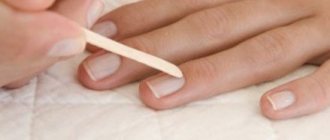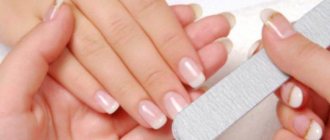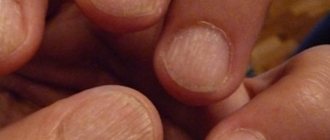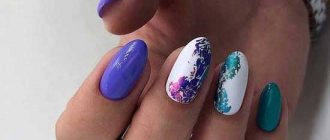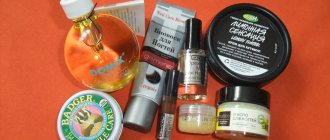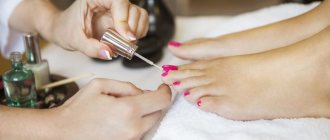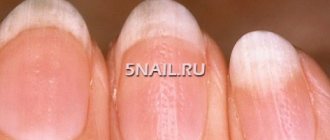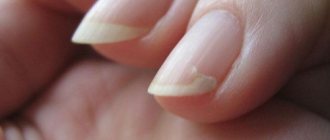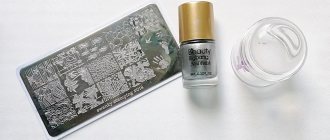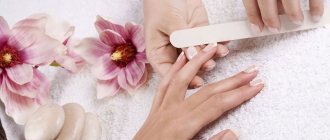Why do your nails hurt after a manicure: the main reasons
As a matter of fact, the nail plate itself, consisting of dense cells - keratinocytes, cannot hurt, since keratinized scales cannot be called alive.
Its natural function is to protect sensitive fingertips from damage, germs, and other possible adverse factors.
loading…
Under and around the plate there is a collection of blood vessels and nerve endings; accordingly, any damage to the nail or the space around it and under it can cause various unpleasant sensations, including extremely painful ones.
So, the main reasons for the appearance of symptoms are as follows:
- Damage to the nail plate itself: thinning, trauma.
- Damage to the periungual fold.
- Injury to the nail bed and matrix (growth layer).
- Exposure to aggressive chemical agents.
- Burns from a UV lamp.
- Infection with fungi and microbes.
- Aggressive manicure without taking into account the individual characteristics of the nail.
I will tell you in detail below about the occurrence of all these reasons after a manicure, methods of elimination and possible preventive measures.
Causes of inflammation
Small wounds, cracks, cuts when removing the cuticle - all this becomes a good breeding ground for infection, especially if you use the foot steaming procedure, when microorganisms from the entire foot get into the water. In addition, it is very important to disinfect instruments before each treatment. If you constantly do pedicures in the salon, then monitor this moment, as this is the most common cause of the inflammatory process. In addition to these aspects that cause inflammation of the big toe after a pedicure, the motivator may also be one’s own health condition:
- Weakened immunity;
- Skin or nail fungus;
- Diabetes;
- Avitaminosis;
- Hormonal disorders.
The resulting inflammation, as a rule, begins with redness of the skin around the nail plate, swelling of the nail fold occurs, which is painful to touch. The temperature can rise to 38 degrees. Pus may accumulate under the swollen skin, causing the finger to feel hot. This syndrome, when a finger becomes inflamed after a pedicure, is expressed in a bright pulsation, which gradually increases and then subsides. The main thing is not to start the inflammatory process, otherwise pus may fill the entire space under the plate and then you will only have to contact a surgeon to remove the nail.
Nails hurt after a hardware manicure: what is the reason?
A properly performed hardware manicure does not pose a threat to the health of your hands, unlike its simpler brother - an edged manicure.
The essence of the method is simple: manipulations to remove overgrown cuticles and care actions are carried out using various attachments of a special grinding device. The nail plate itself is also processed with a cutter in order to remove the gel polish coating and level the free edge.
This method is the least dangerous, and with skillful use and selection of attachments appropriate for each stage of manipulation, it should exclude any types of damage to the nail and skin of the fingers.
If the procedure is carried out incorrectly, you can get the following troubles:
- thinning of the nail plate;
- damage to the skin of the finger;
- addition of infection.
Soreness after a hardware manicure should not be perceived as something normal; most often, such a side effect occurs if the method was not performed on a naturally thin nail plate or without taking into account the increased sensitivity of the skin of the finger.
Due to inexperience or strong pressure during treatment of the area of the side ridges and nail bed, inaccurate movement can cause damage. The risk also increases significantly if you have thin skin and capillaries located close to the surface.
An experienced craftsman is always able to identify such features and exercise caution when performing work. In some cases, it is even recommended to give preference to a gentle European manicure, which is less traumatic, or to combine it with a hardware one. I told you more about the types of manicure in the article Cuticles hurt after a manicure .
In any case, if you feel pain during the procedure, you must inform the specialist about it. If there are obvious signs of injury, urgent antiseptic treatment of the wounded surface is necessary.
Sensitive, thin nail plates, as well as the close proximity of capillaries during aggressive hardware methods, may well explain the fact that the skin around the nails hurts after a manicure. And the reason for this is mainly due to the careless execution of the technique by the master.
Why do my nails hurt after a gel polish manicure?
A very common problem after a decorative manicure, which ends with the application of gel polish, is that pain appears in the nails. I’ll say right away that this shouldn’t be the case, so if similar symptoms occur, the reasons may be as follows:
- Improper removal of old coating. Many gel polish lovers know that it is almost impossible to erase it using simple methods. Removal is recommended using hardware manicure. But sometimes the method is carried out in a completely barbaric way: they place a cotton pad generously moistened with acetone on the plate and wrap the fingertip in foil for a while to prevent the rapid evaporation of the acetone and ensure its maximum contact with a durable decorative coating. This is absolutely not worth doing! Imagine what happens to the nail plate and skin from such a lotion: the last moisture is drawn out, the protective layer is destroyed, ulcerations may appear on the fingers, because acetone is by no means a medicinal cosmetic product. Therefore, if you agree to such a desperate step, be prepared to cause serious damage to the health of your hands. Acetone removal of gel polish is a guaranteed and main reason for complaints that there is pain around the nail after a manicure, and you simply cannot touch the nail plate itself.
- Insufficient lamp power for drying . When performing a manicure using gel polish, it will be necessary to apply a base coat (base) to the nail plate. Under the influence of a UV lamp, it becomes very hot and generates heat. This is precisely the reason that during exposure to the lamp there is a feeling that the nails are “baking”. The shorter the exposure time to ultraviolet light, the faster this sensation passes and the risk of injury to the plate is reduced. Lamps with insufficient power can not only lead to the coating not fully polymerizing, but also become an explanation for why the fingernail hurts after a manicure.
- The primer can also cause pain . This substance is necessary to improve the adhesion of gel polish to the surface of the nail. For manicure with gel polish, two types of primers are used to choose from:
- - based on methacrylic acid, which makes the nail rougher and drier (acidic);
- - sticky with ethyl acetate (acid-free);
And the choice in favor of a specific type of product often depends on the initial quality of your nails. For example, an acidic primer can only be applied to initially strong, dense nails, since it has a strong drying effect, which increases fragility, while an acid-free primer is softer and is suitable for working with thinner plates.
Please note that these substances can only be safe for the nail; if they come into contact with the skin, they can cause chemical burns up to the third degree. Therefore, it is important to be especially careful and prevent such developments.
A manicure with gel polish should not cause pain when worn if done correctly. The only acceptable moment is a slight burning sensation when drying, which should pass quickly and not be felt too sharply.
If after this method of working with nails you still have pain, it means that your plates have been damaged. This also happens if, despite the ban, the work was carried out on weak and soft nails using aggressive agents or too roughly.
Causes
Inflammation of the finger Microcracks and wounds that are easily caused when treating the nail plates and cuticles become an excellent breeding ground for infections. Dirt and bacteria can come from the handyman's tools. After all, salon procedures are carried out for many clients and are not always processed according to requirements. And a home pedicure set collects no less bacterial flora on its surfaces. But this does not mean that you have to give up nail care. The causes of inflammation depend on the state of health:
- Skin and nail fungus;
- Avitaminosis;
- Diabetes;
- Hormonal disorders;
- Ingrown nail.
Treatment of an inflamed finger must be carried out comprehensively. You may need to consult a doctor who will prescribe anti-inflammatory and vitamin medications. A sore on the finger after a pedicure may signal the need to take care of your health.
Why does my finger hurt under my nail after a manicure?
So, we found out that when the nail plate is thinned by chemicals or excessive filing of the top layer, pain may occur when pressing on it or at rest. This kind of damage can be compared to damage to tooth enamel, when the organ begins to respond with pain to any irritant.
But complaints such as “after a manicure it hurts under the nail” and even “after a manicure the finger hurts, it throbs” , and the reason here may be infection of the injured skin.
For example, pulsation with pain is always a sign that the finger is breaking under the nail plate and, in the worst case, can lead to a disease such as paronychia - an inflammatory process in the periungual space.
Untreated forms of this pathology are capable, due to the anatomical structure and favorable conditions (this area is home to a large number of different microbes), to go deep into the tissues and lead to deep forms, which are already called felon. It, in turn, actively involves tendons, joints and even finger bones in the process.
This is a very serious complication that can only be cured using surgical methods, in severe cases requiring removal of the entire plate or even the phalanx of the finger.
Therefore, in no case should such a symptom as pain under the nail be ignored.
Do not ignore additional symptoms that will clearly indicate infection of the periungual space:
- swelling of finger tissue;
- burning sensation;
- redness;
- pain with any type of movement and even at rest;
- feeling of fullness under the nail;
- in a more mature phase of the process, when pressing on the nail, purulent contents may be released;
- Paronychia of the nail bed is noticeable by the presence of a purulent bubble under the skin and an inflammatory formation in the form of a horseshoe around the hole.
Pathology necessarily develops when two factors are combined: trauma to the skin around or under the nail (this is especially dangerous, since inflammatory tissue changes will not be immediately noticeable if a colored decorative coating is applied) and the penetration of pyogenic bacilli or fungi into this area. The main causative agents of the disease are streptococci and staphylococci, Pseudomonas aeruginosa, as well as fungi of the genus Candida. Infections can also be of a mixed type.
It is worth noting that periungual paronychia occurs more often during a classic trimmed manicure, if insufficiently clean tools were used, or if the recommendations for careful handling of fingers were not followed correctly immediately after the procedure.
Subungual forms of pathology can occur for the following reasons:
- injury to the plate itself during aggressive filing, especially when processing the “stress zone” - the point where the boundary between the increment of the plate to the finger and the free edge of the nail lies;
- injury to the skin under the nail - hyponychia, which can occur when correcting the length of an overgrown plate or touching it with a sharp instrument;
- penetration of aggressive chemicals (primer) under the plates that can cause skin ulceration.
Also, the appearance of suppuration and pain under the nail can be a consequence of an allergic reaction, which is accompanied by an increase in the permeability of the skin and, as a result, vulnerability to infections.

